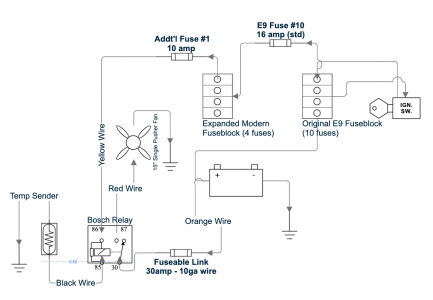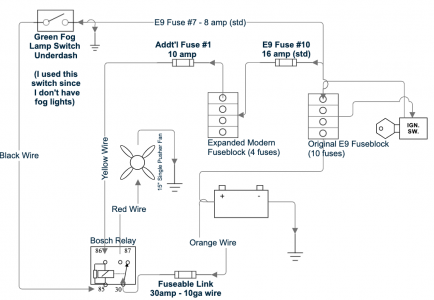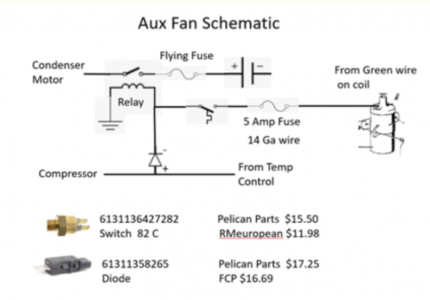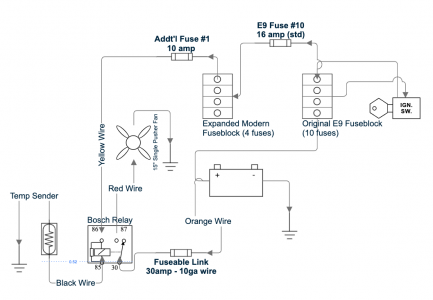Tom P
Well-Known Member
Hi there,
It's been a while since posting but glad to be back and especially glad to see a thriving E9Coupe.com board. I'm reaching with an electrical issue that I seem to have caused myself.
Despite installing and using an electric pusher fan successfully for many years, the temp sensor recently failed on me causing the fan to unknowingly stop working resulting in my coupe overheating. The fan was fused inline and powered through a relay triggered by a temp sensor located on the water pump housing. Not wanting to be surprised by a failed sensor again, I felt that a seemingly simple solution would be to remove the sensor and just run the fan full-time going forward. So, I plugged the sensor hole but decided to run the sensor "trigger" wire to my unused, green fog light switch under dash as a stealth way to turn on/off the fan if ever needed. I felt this was safe due to the low amperage needed to trip the relay. This worked well until about my 3rd outing when the fan stopped working. I checked the fuses and see that the inline fan fuse burned and my fuse 7 burned as well.
I removed the fan wiring to isolate that component and then using a test light w/probe (and no fuses installed in my fuse block), I see that my D+ blue wire lead at my unused voltage regulator socket lights up. My fuel pump wire light up at the pump, my lower tabs on fuse block at fuse 1, 2, 3, 6, and 7 light up (# 6 lights up very dimly and illuminates the red "L" indicator on my dash), and I'm not getting any lights when the upper tabs are probed (although an under dash relay is triggered when upper 6 and 7 tabs are probed - but no light).
So, I'm concerned there's a ground fault somewhere but thankfully not seeing any burned wires anywhere. Any ideas where to look next?
Thank you!
It's been a while since posting but glad to be back and especially glad to see a thriving E9Coupe.com board. I'm reaching with an electrical issue that I seem to have caused myself.
Despite installing and using an electric pusher fan successfully for many years, the temp sensor recently failed on me causing the fan to unknowingly stop working resulting in my coupe overheating. The fan was fused inline and powered through a relay triggered by a temp sensor located on the water pump housing. Not wanting to be surprised by a failed sensor again, I felt that a seemingly simple solution would be to remove the sensor and just run the fan full-time going forward. So, I plugged the sensor hole but decided to run the sensor "trigger" wire to my unused, green fog light switch under dash as a stealth way to turn on/off the fan if ever needed. I felt this was safe due to the low amperage needed to trip the relay. This worked well until about my 3rd outing when the fan stopped working. I checked the fuses and see that the inline fan fuse burned and my fuse 7 burned as well.
I removed the fan wiring to isolate that component and then using a test light w/probe (and no fuses installed in my fuse block), I see that my D+ blue wire lead at my unused voltage regulator socket lights up. My fuel pump wire light up at the pump, my lower tabs on fuse block at fuse 1, 2, 3, 6, and 7 light up (# 6 lights up very dimly and illuminates the red "L" indicator on my dash), and I'm not getting any lights when the upper tabs are probed (although an under dash relay is triggered when upper 6 and 7 tabs are probed - but no light).
So, I'm concerned there's a ground fault somewhere but thankfully not seeing any burned wires anywhere. Any ideas where to look next?
Thank you!




